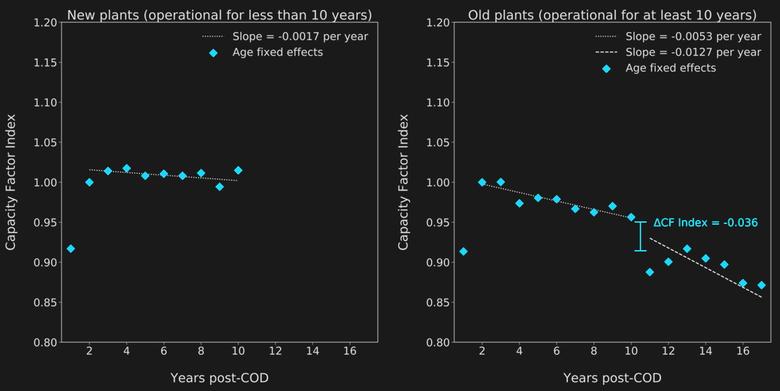
CHANGES OF WIND PLANTS PERFORMANCE

By Dev Millstein Research Scientist Lawrence Berkeley National Laboratory
ENERGYCENTRAL - A new study by Lawrence Berkeley National Laboratory (Berkeley Lab) investigates how the performance of wind plants in the United States changes as they age. The study finds that output from the typical wind plant declines by about 13 percent over 17 years. Furthermore, plants of 10 years of age or less showed very little performance decline overall (-0.17 %/yr).
The research is based on data from 917 wind power projects in the US. It provides the first comprehensive evaluation of its kind for the United States. The study is open acess and appears in the peer-reviewed journal Joule.
The study authors will summarize key findings via a free webinar on May 20th, 11 AM Pacific/2 PM Eastern. Register here.
Average decline in performance with age for two cohorts of plants. COD stands for commercial online date. The y-axis can be interpreted as a ratio of performance to year 2, so, for example, a value of 0.95 indicates that a plant produced 95% of the energy in a particular year compared to year 2 of life (after weather correction).
A major influence on the performance of older plants (built before 2008) is the federal production tax credit, which provides incentives for energy output during the first 10 years of plant life. Plant performance declined abruptly after the 10 year tax credit ran out, suggesting that the tax credit gives plant operators strong incentives to maintain turbines. This drop in performance after 10 years was not found in prior studies focused on European wind fleets, in which performance decline was constant over time.
The study finds that turbines sited on flatter terrain, with lower specific power and direct drives (rather than gear boxes) have lower rates of performance decline. Flatter terrain may be associated with less wind turbulence, and thus less stress on the turbines, but data on turbulence is not systematically available. Turbines with low specific power ratings have longer blades relative to their generator size, and are becoming increasingly popular. Direct drive turbines are not common in the US projects, with less than a dozen in the projects sample.
Factors that had no discernible effect on performance decline included overall project capacity, amount of nearby capacity at other wind plants, size of plant owner (i.e., owners of many projects versus owners of a single project), and original equipment manufacturer.
The performance of wind plants may decline over time due to a number of reasons, such as increasing downtime for maintenance, erosion of blade edges, or increased friction within rotating components. It is also possible for performance to improve if software, or even hardware, updates are installed. However, in most cases plant performance tends to decline slightly with age.
This performance decline rate is an important input into estimates of a plant’s lifetime generation output and estimates of a plant’s financial viability. This rate is also important in research contexts, for example, as an input into long-term energy sector models and as input to estimates of the levelized cost of wind energy. Despite its importance, little information is publicly available as to how U.S. wind plant performance changes with age. Due in part to the lack of information, the performance decline rate is often not accounted for by investors, energy modelers, and policy makers.
These results can be used to refine energy and financial assessments for investors and can be incorporated into forward-looking energy system models for policy makers.
Support for this study was provided by U.S. Department of Energy’s Office of Energy Efficiency and Renewable Energy.
Study authors are Sofia Hamilton, Dev Millstein, Ryan Wiser, Mark Bolinger, and Seongeun Jeong
-----
This thought leadership article was originally shared with Energy Central's Clean Power Community Group. The communities are a place where professionals in the power industry can share, learn and connect in a collaborative environment. Join the Clean Power Community today and learn from others who work in the industry.
-----












